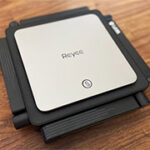The Reyee RG-E5 is the current flagship WiFi 6 router model from who I initially assumed to be a completely new player in the consumer-based networking market. But Reyee is actually being owned by Ruijie Networks which has a long history of developing enterprise-level networking hardware (well over two decades), so the Reyee brand can be seen as a means to make a fresh entry into the crowded consumer-based market.
| Reyee RG-E5 | |
|---|---|
| Amazon.com | Check Offer |
It was also interesting to see that Ruijie Networks has been busy releasing WiFi 5 routers and even a WiFi 4 model last year in an attempt to cover more ground. The Reyee RG-E5 doesn’t really push boundaries, but it definitely promises to offer a very similar experience to the Asus, TP-Link or Netgear WiFi 6 routers, if not better. There is OFDMA which is pretty much a standard feature on any WiFi 6 router, but it’s not usually enabled on both radio band, nor are they upstream and downstream.
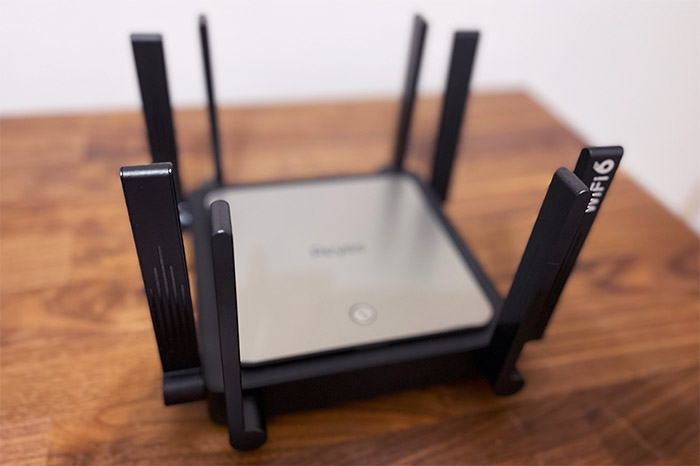
Then, there’s the four high-gain antennas (+ four other FEM antennas) which should increase the coverage, if necessary, as well as the support for MU-MIMO and a few interesting software features. Reyee prides itself with IoT security, Internet privacy and comprehensive Parental Controls, but we’ll see if it can actually rival what Asus has to offer at no additional cost.
Lastly, there is support for creating a mesh system which was spectacular a few years ago when Asus released the AiMesh, but it has (unsurprisingly) become more common with other brands as well. It’s still a phenomenal feature especially if the compatibility spans over multiple WiFi standards and generations of wireless routers. That being said, let’s put the Reyee RG-E5 to the test and see what it has to offer.
Design and Build Quality
Design-wise, the Reyee RG-E5 doesn’t look like the other routers on the market and that’s a good thing when most follow a very similar blueprint. Don’t get me wrong, it’s still a rectangular case with antennas, but the way the eight antennas are positioned and need to be raised is fairly unique. The gray top on the rectangular body is also a nice choice and I know that it may not be everyone’s cup of tea, but I liked the design of the Linksys WRT3200ACM, so, naturally, I liked what the designers did with the Reyee RG-E5 as well.
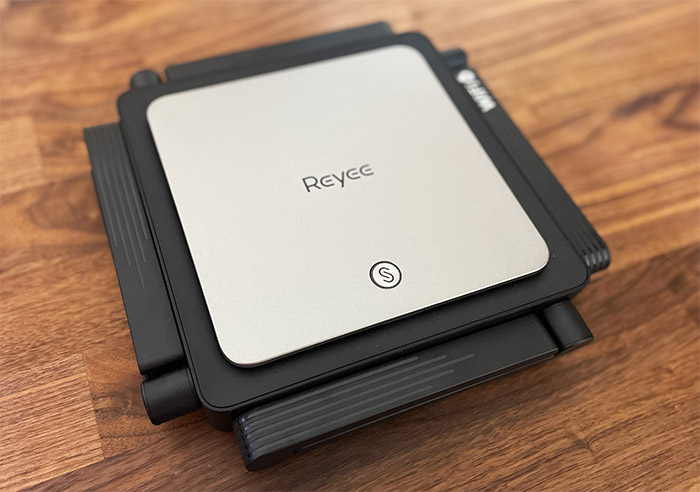
After raising up all antennas, I did check around the case to see if there are enough ventilation holes and I could see a divide between the gray top and the black matte base side, and there are also lots of cut-outs on the bottom side of the router. But is that enough to ensure a good enough airflow? It does because router only gets warm at the top and bottom, but there were no signs of overheating.
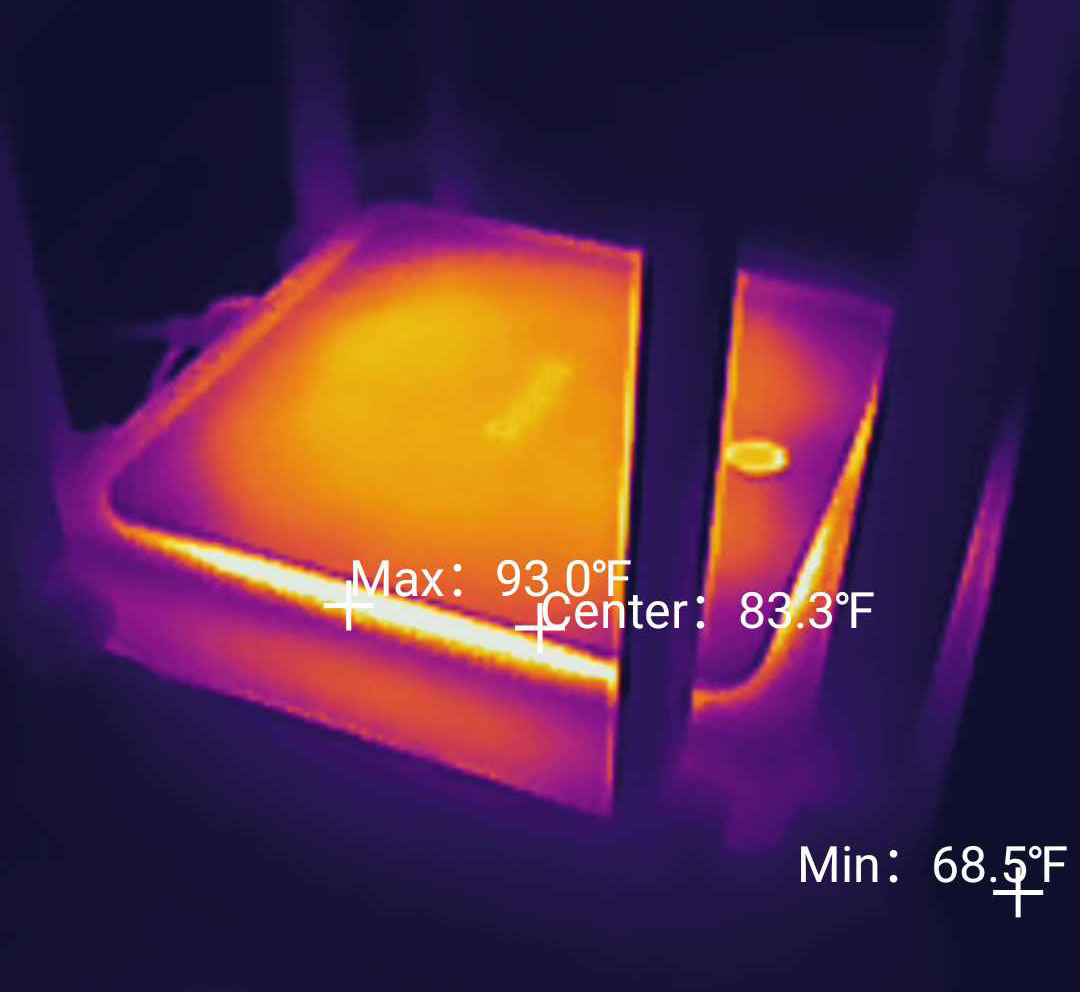
Besides the ventilation holes, I could also see the two silicone bands that keep the Reyee RG-E5 into place regardless of the number of cables you connect to it, but I didn’t see any mounting holes. I am not sure why they decided against it especially due to the unorthodox design, but yes, you’re stuck with keeping the wireless router on a desk. And it’s not really that small either. The Reyee RG-E5 measures 9.1 x 9.1 x 1.5 inches (23.1 x 23.1 x 3.8 cm), so it will take some space from the furniture which, in an office, may not be that great – just add some mounting holes on the next iteration, please.
The minimalist fever has caught Reyee as well and we don’t get a healthy array of status LEDs and, instead, there are two LED lights, one at the top embedded into the S button (the Mesh indicator), while on the front, there’s the secondary LED which shows the status of the wireless router.
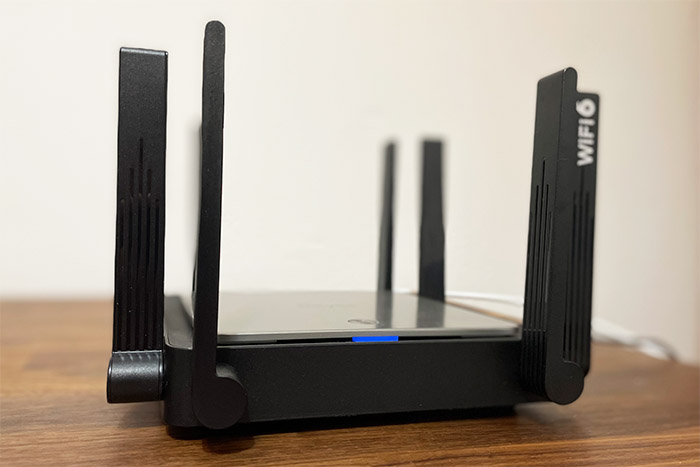
The status LED is fairly basic since it will be solid blue when everything is working fine and it will flash blue when the device is starting up or returning to factory settings. The Mesh indicator has been blessed with more functions since it’s solid red when the mesh network is disconnected and flashing green when you’re pairing the Reyee RG-E5 to a mesh network.
If the LED is solid orange it means that the signal is weak – move the router closer to the primary mesh node – and, if it’s solid green, then the signal to the main mesh node is strong. So yes, check the app for actual status info. That S button requires more attention because it can be used to pair the router to an existing mesh network or to add other mesh nodes to the Reyee RG-E5 network.
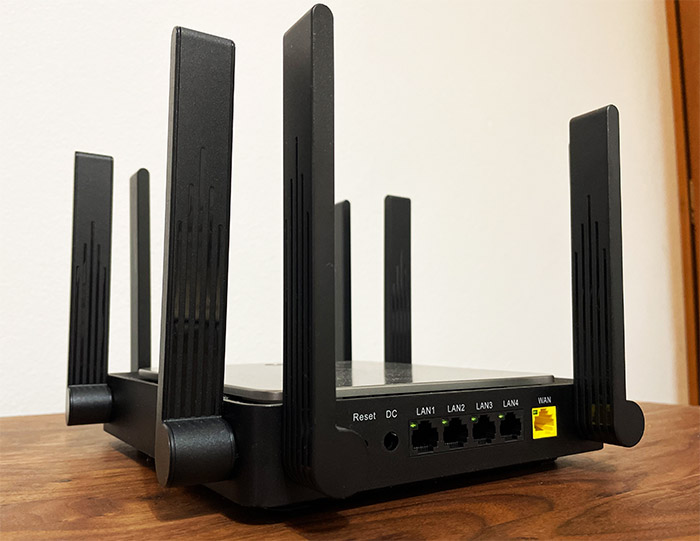
This means that it functions as WPS which is not the best approach (nor the most secure). On the rear side of the Reyee RG-E5, you’ll be able to find a Reset button, followed by the Power connector and then there are four LAN ports and one WAN port. All five Ethernet ports are Gigabit and each has a dedicated status LED next to it. It’s unfortunate that the manufacturer decided to not add a USB port as well.
Note: The Reyee RG-E5 is the same device as the RG-EW3200GX PRO.
Internal Hardware (Reyee RG-E5 Teardown)
Unlike other brands, Reyee doesn’t stop you from opening up the case with silly stickers, but that doesn’t mean that the warranty can’t be voided if you’re damaging the interior of the device. That being said, to check out the internal components of the Reyee RG-E5, you need to remove the four screws from the bottom of the case (hidden underneath the two silicone bands) and then to gently pry open the top of the router.
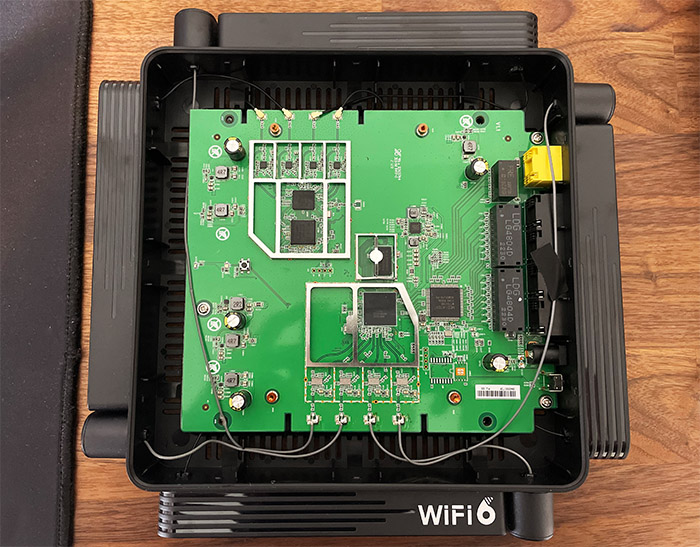
Doing so will reveal the PCB with the large heatsink and the eight antennas. I saw that four antennas are attached via connector and four are soldered to the board. The large heatsink can easily be detached after removing the four screws, and then the main chips are covered by aluminum protections. After removing them, I could identify the Mediatek MT7531BE switch chip, the Mediatek MT638GN PMIC, 256MB of RAM from Nanya NT5CC128M16JR-EK and on the other side of the PCB, I was also able to identify 16MB of flash memory from XMIC 25QH128CHIQ, which is really not that much.
Then, I could see the dual-core 1.35GHz Mediatek ARM MT7622BV SoC which is also used for the 2.4GHz radio band (802.11b/g/n/ax 4×4:4 + 4X Skyworks SKY85331-11 front-end modules). I do need to mention that the soldered antennas are for the 2.4GHz frequency band, but the way the cables are routed within the case is not very optimal.
I say that because one of the cables was too close to one screw which damaged it a bit and may affect the WiFi performance – I did put it in another position but do be aware that this can happen to you as well. Lastly, just like the Ubiquiti U6-LR WiFi 6 access point, the Reyee RG-E5 uses the combination between Mediatek MT7915AN and Mediatek MT7975AN 802.11a/b/g/n/ac/ax 4×4:4 + Bluetooth 5 chips + 4x KCT8539S highly integrated RF front-end modules for the 5GHz radio band.
| Reyee RG-E5 | TP-Link Archer AX50 | Asus RT-AX58U | Netgear RAX40 | |
| CPU | dual-core 1.35GHz Mediatek ARM MT7622BV | dual-core 800MHz Intel AnyWAN GRX350 | tri-core 1.5GHz Broadcom BCM6750KFE8G | dual-core 800MHz Intel (Lantiq) PXB4395 |
| RAM | 256MB Nanya NT5CC128M16JR-EK | 256MB Samsung (K4B2G1646F-BYMA) | 512MB Nanya 1930 NT5CC256M16ER-EK | 512MB from Samsung |
| Storage | 16MB XMIC 25QH128CHIQ | 128MB ESMT (F59L1G81MA AZY1P0AMT) | 256MB Macronix MX30LF2G18AC-TI | 256MB Macronix MX30LF2G18AC-TI |
| Switch | Mediatek MT7531BE | Intel GRX350A3 | Broadcom BCM6750KFE8G | Intel AnyWAN GRX350 |
| 5GHz Radio | Mediatek MT7915AN and Mediatek MT7975AN 802.11a/b/g/n/ac/ax 4×4:4 | Intel WAV654A0 802.11a/n/ac/ax 2×2:2 | Broadcom BCM43684 an/ac/ax 4×4:2 | Intel WAV654 802.11a/n/ac/ax 2×2:2 |
| 2.4GHz Radio | Mediatek MT7622BV 802.11b/g/n/ax 4×4:4 | Intel WAV654A0 802.11b/g/n/ax 2×2:2 | Broadcom BCM6750 b/g/n/ax 2×2:2 | Intel WAV654 802.11b/g/n+ax 2×2:2 |
The WiFi Features
Before anything else, let’s talk about the antennas because the manufacturer has made some interesting claims. Besides dedicating four antennas to the 2.4GHz radio and four to the 5GHz radio band, which seem to be able to properly handle both vertical and horizontal antenna signals from the client side (you can see here just how important the antenna positioning is), Reyee says that four antennas are high gain which means that the signal should reach farther.
I wondered just how high-gain they are, so I checked the FCCID page of the router and it seems that for the 2.4GHz radio, the four antennas have an average gain of 4.6dBi, while the four antennas for the 5GHz radio are, on average 5.5dBi (the Beamforming gain is 6dB).
It’s definitely a bit above average, but in line with the more powerful models out there, including the Asus RT-AX88U. As for the WiFi 6-related features, there’s OFDMA which is incredibly useful in a very dense Wifi environment since it can push data packets simultaneously to multiple clients via sub-carriers. This can also include users that live in apartments and every neighbor is blasting its WiFi without limiting some of the values in the settings (and they never do).
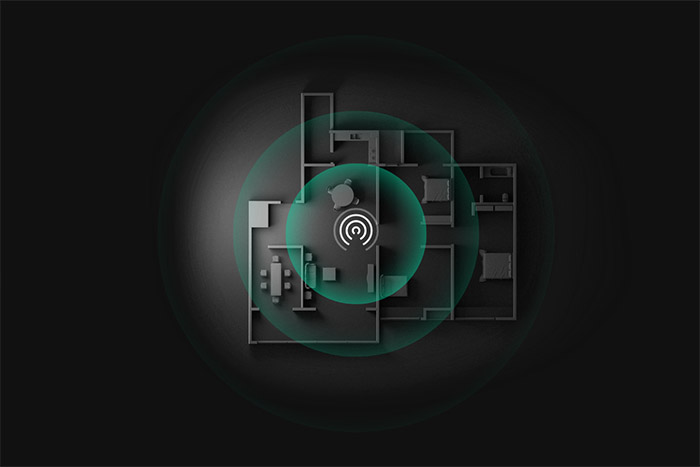
This can lead to a very high amount of interference, so it’s not just business offices with lots of access points. Besides OFDMA, there’s support for MU-MIMO which is a good option if you have compatible client devices, and I bet most of you don’t. There is no support for 160MHz channel bandwidth to help you get great WiFi speeds when you live in the middle of nowhere, so we’re not really missing much, but the Reyee RG-E5 can become a part of a mesh network.
The mesh systems have put this technology approach into mainstream and seeing it on stand-alone routers is always nice since it can cover an area with WiFi far better than having to rely on a wireless repeaters or any other shenanigans. But I was curious to see if other, less equipped models from Reyee would support mesh. And, after checking out the RG-E3, it does seem to support Reyee’s approach to the mesh tech which is great for present and future models.
The Wireless Test (5GHz)
The Reyee RG-E5 is limited to the 80MHz channel bandwidth which is hardly a handicap in a busy area, so I don’t think it’s that big of a deal in most cases. That’s why I ran some tests using a WiFi 6 client device (Intel AX200), as well as a couple of WiFi 5 clients while they were connected to the 5GHz network (80MHz).
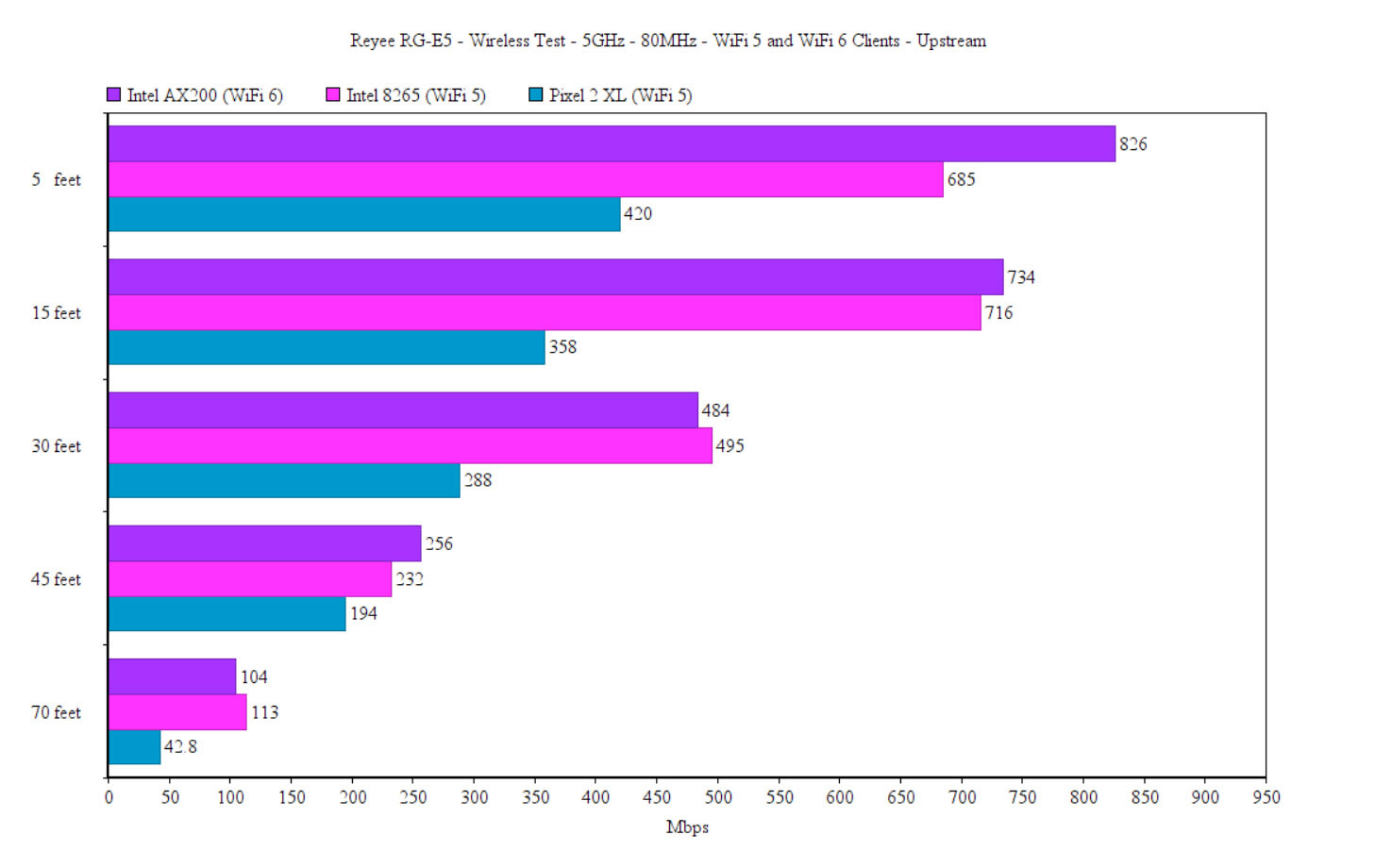
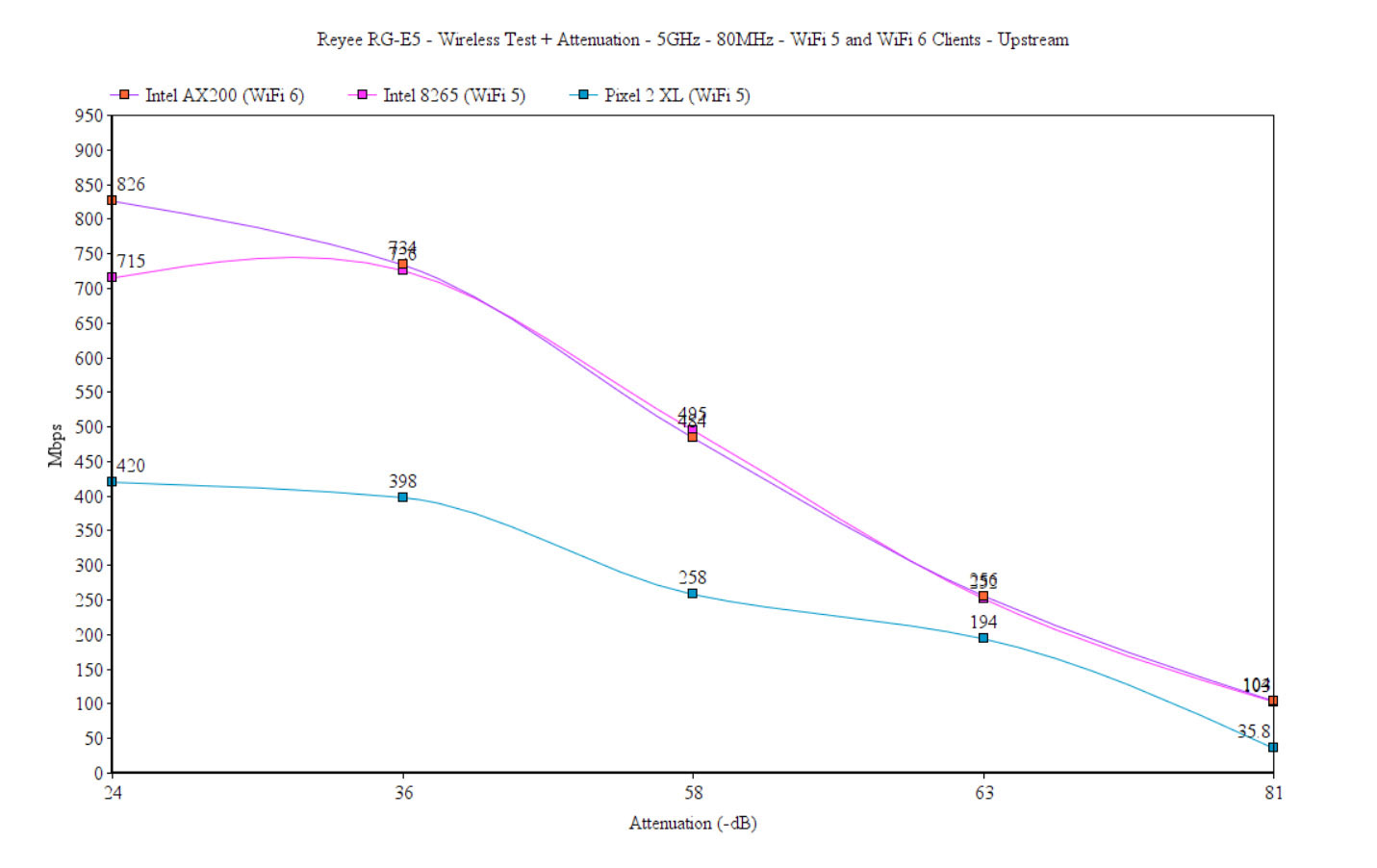
Just for the fun of it, I left the transmit power to auto (which is the maximum, trust me), so, moving data from the WiFi 6 client device to the server, I saw an average of 826Mbps upstream and 490Mbps downstream (-24dB attenuation, so the signal is strong at 5 feet). But, since I let this test run for hours, I could see that from time to time, there were packets drops and it wasn’t just the inability to handle the Java scripts or any other type of script, the Internet speed would slow down temporarily.

This behavior disappeared almost completely at 15 feet, where even if the upstream throughput was 734Mbps (and an excellent 491Mbps downstream), the packet drops simply vanished. So, if you have important client devices at less than 15 feet from the router, make sure to lower the power transmit just a bit on the 5GHz to not overwhelm the client device.
Reyee RG-E5
-Pros
- Support for Cloud controller (which is free)
- Cool design
- High gain antennas = very good throughput at long distances
- WiFi 6 features, such as OFDMA
- Can be a part of a mesh network
Cons
- No USB port
- One antenna cable was damaged by a screw (the internal layout doesn't seem to be optimal for the antennas)
- The Parental Controls layout is nice, but the options are actually quite basic
- Chaotic app-based installation (just use the web-based interface)

Mark is a graduate in Computer Science, having gathered valuable experience over the years working in IT as a programmer. Mark is also the main tech writer for MBReviews.com, covering not only his passion, the networking devices, but also other cool electronic gadgets that you may find useful for your every day life.

